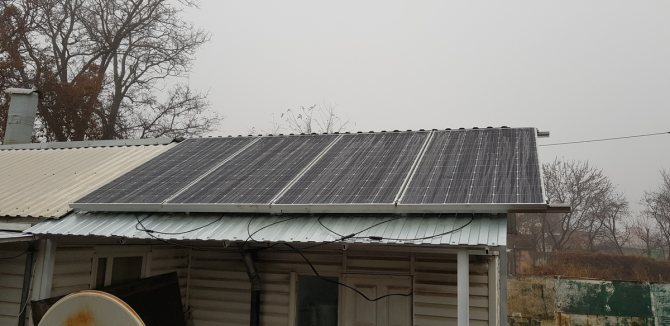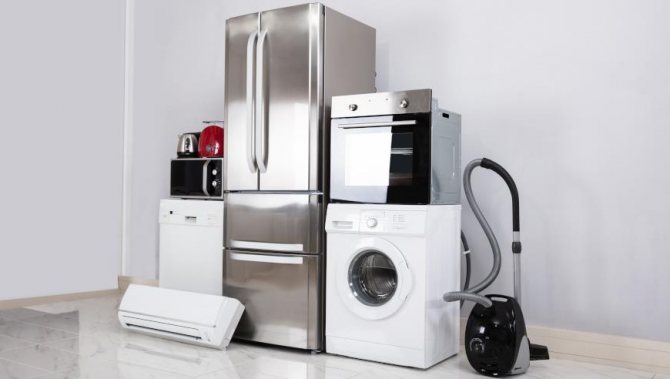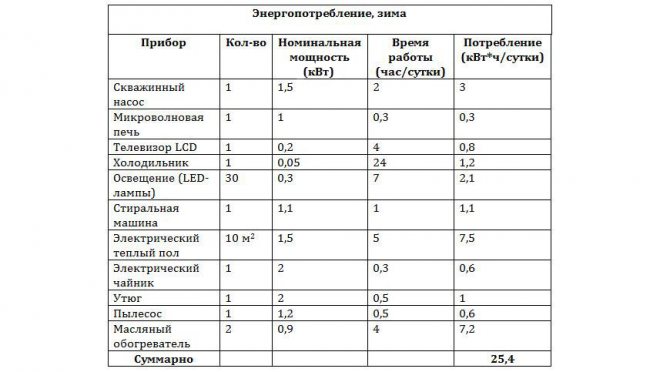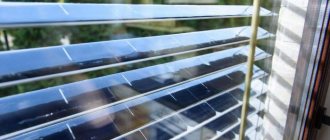
Created: 19 December 2019
Very often, when applying for the selection of equipment or when choosing a solar power plant, customers ask the question: How to calculate the power and number of solar panels and batteries and what power to choose a solar power plant. In this article we will try to deal with this issue, and I will try to explain in simple language, without going into details, how to do this.
First of all, you need to find out how much electricity you consume per day, this can be done by taking the average monthly electricity meter readings and dividing by 30 days. So we get the average consumption per day. For example, the social norm in RO for two people is 234kW, which is about 8kWh of electricity per day. Accordingly, we need solar panels to generate the same amount of energy per day.
Calculation of the number of solar panels and their capacity
Since solar panels generate electrical energy only during daylight hours, then this must be taken into account first of all, it is also worthwhile to understand that production on cloudy days and in winter is very much reduced, and can be 10-30 percent of the power of the panels. For simplicity and convenience, we will calculate from April to October, by the time of day, the main production runs from 9 am to 5 pm, i.e. 7-8 hours a day... In summer, the intervals will of course be longer, from sunrise to sunset, but during these hours the output will be much less than the nominal, so we are averaging.
So 4 solar panels with a capacity of 250W. (1000W total). 8 kWh of energy will be generated per day, i.e. per month it is 240 kWh. But this is an ideal calculation, as we said above, on cloudy days the output will be less, so it is better to take 70% of the output, 240 * 0.7 = 168 kWh. This is an average calculation without losses in the inverter and batteries. Also, this value can be used to calculate a network solar power plant where batteries are not used.


Calculation of solar panels
The required power of solar panels is calculated according to the weather in the area and the radiation intensity at different times of the year. The angles of inclination horizontally and vertically are of great importance in the calculations. This indicator is especially important if the solar system will be in operation all year round. The location of the equipment will also depend on this. If the angle of inclination does not require adjustments, then the panels can be placed directly on the roof of the building.
The most important measure is the calculation of solar panels, the number of modules and their efficiency. The data is taken for the best and worst month in terms of energy efficiency. For calculations of standard insolation, an area of 1 m2 is selected, and to determine the nominal power, a temperature of 25C is required, with a standard luminous flux of 1 kW / m2.


The determination of the performance of the solar battery during the month is carried out according to the following formula: Esb = Eins x Rsb x η / Rins. Its variables correspond to the following indicators:
- Esb - the amount of energy generated by the battery.
- Eins is the result of a monthly insolation of 1 m2.
- η is the value of the overall efficiency in the transmission of current through conductors.
- Рсб is the rated power of the solar panel.
- Rince is the highest insolation power of 1 m2 of the Earth's surface.
When calculating, it is necessary to use units that are the same for all indicators. Typically, these are joules or kilowatt hours. By calculating the monthly insolation, you can easily determine the nominal power of the solar panel required to generate a monthly amount of electricity: Рсб = Рins х Есб / (Еins х η).
It should be noted that the voltage at the output of the solar panel will be 15-40% higher than the battery voltage. When using cheap controllers, this difference invariably goes to waste. More expensive modern models can reduce this figure to 2-5%.
Solar radiation has different power ratings, depending on the season and the specific month. The nominal power of the panel itself remains unchanged, therefore, the correct choice of the place of its installation is of great importance. Using the formulas above, only an approximate number of modules can be determined. To obtain an accurate value with the necessary margin, double the number of panels is taken, corrected for night time, cloudy days, snowfalls and other factors that reduce the efficiency of the system.
Calculation of batteries for a solar power plant
Next, let's move on to calculating the battery capacity for solar panels. Their quantity and capacity should be such that the energy that is stored in them is enough for the dark time of the day, it is worth considering that at night the consumption of electricity is minimal, compared to daytime activity.
100Ah battery stores approximately 100A * 12V = 1200W. (a 100W light bulb will work from such a battery for 12 hours). So if you consume 2.4 kWh per night. electricity, then you need to install 2 batteries of 100Ah each. (12V), but here it should be borne in mind that it is undesirable to discharge the batteries by 100%, and better not more than 70% -50%. Based on this, we get that 2 batteries of 100Ah each. will store 2400 * 0.7 = 1700Wh. This is true when discharging with small currents, when connecting powerful consumers, a voltage drop occurs and the capacity actually decreases.
If you want to calculate how much battery capacity is needed for a solar battery, below is a correspondence table (for a 12V system.):
- Solar battery 50W. - battery 20-40 A.h.
- 100W. - 50-70 A.h.
- 150W. - 70-100 A.h.
- 200W. - 100-130 A.h.
- 300W. - 150-250 A.h.
Analysis of calculations
Taking into account the weather conditions and the rated power of the batteries, we can conclude that a 400 W battery in Moscow will not be enough even to support the emergency mode in the summer. Although for giving, an excess of the emergency level of 80% can be considered an acceptable option, especially with the intermittent operation of the inverter, but only when it is necessary to supply electricity.
Low-power systems are not designed for round-the-clock domestic power supply, even in summer. Since the energy in such systems is critical for the self-consumption of the charge controller and inverter. In winter, the power of the solar collector will not be enough for the operation of all electrical appliances at home, but in the summer it is quite acceptable that the power supply will be uninterrupted.
Battery capabilities from power calculations for Moscow:
- 500 W - gives an emergency minimum of 80% from May to the end of August;
- 600 W - mid-March - September;
- 800 W - when the emergency level is exceeded (except for December and January), it provides voltage from March to September;
- 1 kW - provides basic electricity consumption for almost the entire year, but in winter (December and January), energy may not be enough;
- 1.2 kW - provides a moderate mode in July, in March - September the basic power consumption mode. The emergency minimum falls on the period November - January;
- 2 kW - maintains a comfortable mode, or close to it in the period May - August and basic from February to August. But in the long, dark months, this solar collector capacity may not be enough;
- 3.2 kW - provides a comfortable mode for all long days and throughout the year allows you to count on an emergency minimum;
- 5.3 kW - batteries of rated power, allowing almost unlimited use of electricity in the period May - August and all year round in basic mode;
- 8 kW - the power of the solar battery, which ensures the use of electricity all year round in a moderate mode;
- 13.5 kW - year-round comfortable power consumption mode.
Inverter power and losses
Now, as for the inverter, it also has its own efficiency, which is about 75-90%, i.e. all obtained values of energy production and reserve can be attributed to these percentages. As a result, it is better to take a double reserve of capacity for batteries, So when consuming 2400Wh per night, install 4 batteries with a capacity of 100Ah. 100A * 12V * 4 = 4800Wh. The power of the inverter shows the nominal load that can be connected to it., i.e. the number and type of household appliances.
As a result, we get a solar power plant for 2.5 kW:
- Solar panels 4pcs. 250W each. Generation per month 170-240 kWh (36 thousand rubles)
- Battery 100Ah each. 4 things. stock up to 4800 watts. (AGM batteries 50 thousand rubles)
- Inverter 2.4 kW rated power of the connected equipment (27 thousand)
Total 113 thousand rubles. for a set of equipment.
Maximum load and average energy consumption
At the moment, not everyone can afford to install a solar-powered substation in their country house. Nevertheless, when planning their installation, you first need to find out what peak load should be expected when household appliances are turned on, as well as what average amount of electricity they consume per day.
The maximum load level is determined based on the maximum power of all electrical appliances in the house, so that when several of them are turned on at the same time, the system in the house can cope with the load.


To determine the average daily consumption of each of the devices, its power should be multiplied by the operating time from the network per day. And the total energy consumption is found by summing up the energy from all appliances in the house.
Determining the overall energy consumption metrics will allow you to plan the efficient use of solar energy generated by solar panels. In addition, the figures obtained make it possible to calculate the power of solar panels for the home, in order to know which battery you will need to buy. The capacity of the battery directly affects its cost.
Household appliances power, electricity consumption
Now, with regard to consumers and their capacity, here are the main ones:
- Led TV - 50-150W.
- Refrigerator class A - 100-300W. (only when the compressor is running)
- Laptop - 20-50W
- Energy saving lamp - 30W, LED 3-9W
- Wall-mounted boiler (electronics + built-in pump) - 70-130W.
- Router - 10-20W.
- Air conditioner 9 - 700-900W.
- Email Teapot - 1500W.
- Microwave - 500-700W.
- Washer - 600 - 900W.
- DVR + 4 cameras - 30-50W.
All powers are indicated per hour of operation of the device, it should be borne in mind that most devices work for a short time, the kettle is heated for 5 minutes, the refrigerator turns on every 2-3 hours for an hour to maintain the pace. The boiler pump also works as the temperature of the coolant is maintained. You can also calculate other devices according to this principle.
What's Included in the Solar System Kit
To obtain current, it is not enough to purchase solar panels and connect them. The solar system consists of many equally important technical devices, thanks to which the desired effect is created. So, in order for your home to have electricity of environmentally friendly origin, in addition to solar panels, you will need to purchase 6 more basic elements of the system, namely:
- generator;
- inverter;
- battery;
- solar charge controller;
- consumer 230V;
- connecting box.
Therefore, before you start designing the installation and placement of a photovoltaic system, you must understand that this is much more expensive than buying solar panels alone.The service life and efficiency of the selected elements will depend on the number of modules, class and manufacturer's firm. Correctly selected technical characteristics, reliability of the device and the location of solar panels will be the key to high-quality performance and durability.
Calculating the number of batteries for the home
To calculate how many batteries you need for your home, you need to estimate the values of several key parameters. Let's take a look at everything in order.
Energy consumption calculation
To calculate the required number of panels, you need to start by making a list of all electrical appliances and their operating time, taking into account the power. Only after you draw up a technical description of the system, you can calculate the total demand of the house, which is a mandatory step for calculating the number of solar panels. The table below shows the values of individual electrical appliances to help you calculate.
| Electrical appliance | Power, W | Hours of work per day | W / hour |
| Fridge | 250 | 24 | 6000 |
| Electric kettle | 1000 | 0.3 | 300 |
| Television | 150 | 6 | 900 |
| Radio | 4 | 2 | 8 |
| Economlamp 1 | 20 | 6 | 120 |
| Economlamp 2 | 15 | 4 | 60 |
| Economlamp 3 | 10 | 2 | 20 |
In order to correctly calculate the cost of electricity in your home, depending on the number of devices, you can see the power of each individual device in its technical documentation or on the Internet on the manufacturer's website.
After you have calculated, you need to correct the values, since the solar battery takes on 100% direct current, which is converted into alternating current with the help of the inverter, as a result of which up to 20% of the voltage is lost. You should also take into account the fact that the starting power of any electrical device is several times higher than that stated in the passport, therefore, when calculating the total consumed electricity, you need to leave an error that will be used by the inverter for the first few seconds when the device starts up. If there are a lot of such powerful devices in the house and they can turn on at the same time, then it is better to provide a separate turn on for starting.
Determining the amount of energy from the sun in a specific area
The amount of power generated by solar panels depends on the region and solar radiation. Such indicators cannot be calculated or measured independently, for this you need to contact the hydrometeorological station or the reference book for data. It can be found on the Internet, it is enough to indicate in the search your city and the definition of solar radiation. After you collect the necessary information, you need to use the following formula to determine the amount of energy:
Average annual solar radiation: kW * h / m2 / day
Since the sun shines at different times of the year with different levels of radiation, it is advisable to calculate its value based on the indicators for the whole year, that is, use the average value, of course, if you want to use solar panels all year round. Based on the calculated data, you can determine the number and power of the solar module. For example, consider the values of Moscow, Kotelnicheskaya embankment, latitude 55.7.
| Jan | Feb | March | Apr | May | June | July | Aug | Saint | Oct | Nov | Dec | Average (year) | |
| Horizontal bar | 0.53 | 1.24 | 2.56 | 3.71 | 5.21 | 5.56 | 5.36 | 4.2 | 2.76 | 1.34 | 0.62 | 0.38 | 2.79 |
| Vertical panel | 0.69 | 2.07 | 3.38 | 3.12 | 3.49 | 3.36 | 3.51 | 3.34 | 2.88 | 1.87 | 1.29 | 0.83 | 2.49 |
| Panel tilt, 40 degrees | 0.66 | 1.89 | 3.5 | 4.25 | 5.36 | 5.43 | 5.41 | 4.68 | 3.49 | 1.96 | 1.16 | 0.71 | 3.21 |
| Rotation around the polar axis | 0.7 | 2.23 | 4.29 | 5.38 | 7.35 | 7.59 | 7.25 | 6.1 | 4.22 | 2.31 | 1.41 | 0.84 | 4.14 |
These approximate indicators and the given formula allow you to make the most accurate calculations for the selection of power and the number of solar panels, however, except for those cases when there is an extremely long period of rainy or cloudy weather.
Calculating the number of batteries
Based on the previously given values for energy consumption of electrical appliances, as well as the level of solar radiation, you can determine the right amount of solar panels to provide electricity to your home.So, we take the value of radiation from the table for the month or period you are interested in, and after that we divide it by 1000. The resulting value is called pico-hours, in 1000 W / m2. And the solar module, in turn, generates such an amount of energy, where Pw is the power, E is the insolation value for the selected period, k is a coefficient equal to 0.5 in summer and 0.7 in winter:
W = k Pw E / 1000
The W factor corrects for the power loss not only consumed by the inverter or the starting gap when electrical appliances are turned off, but also the oblique incidence of the beams that varies throughout the day. The above formula and the required amount of energy consumed in the house (previously calculated) allow you to determine the total power of the module and thereby understand how many solar panels you need to fully provide. Batteries with a capacity of 50 W and above are presented today. The generator can be used to adjust the required value.
It is very important not to select solar panels end-to-end according to the calculated power, for example, if the average energy consumption of a house is 68W, you should not buy one module with a power of 70W, it is better to buy two 50W panels or use solar electricity partially, and not for permanent use. But experts advise that if you have already taken up such a question as providing a house with an ecological current, then it is better to calculate the indicator in excess.

















